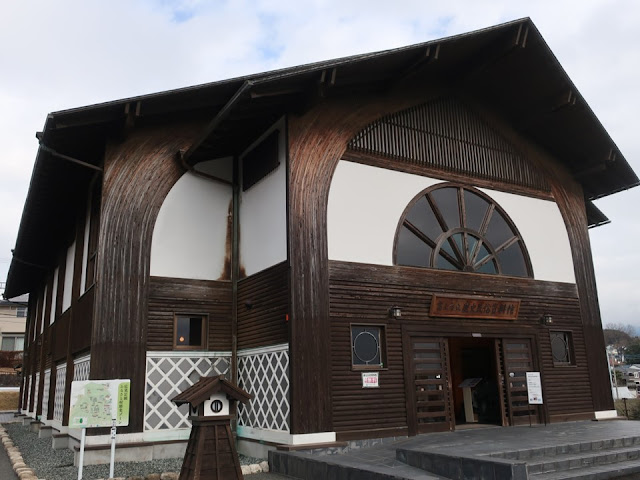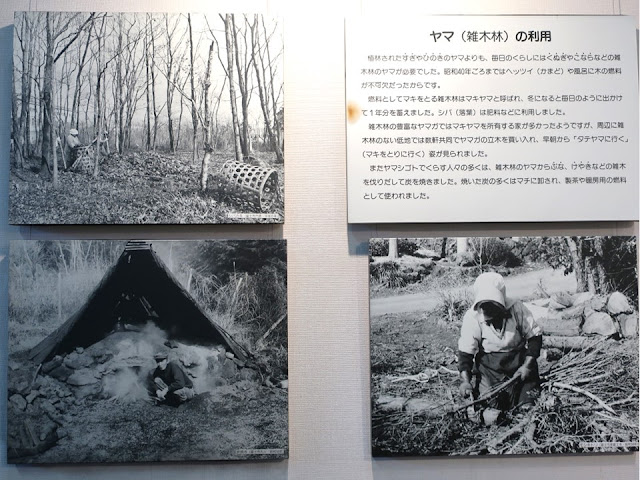“History and folklore Museum” is one of annexes of Mt.Fuji and Princess Kaguya Museum. We can know
the livelihood and life of locals very well, although it’s not easy to find
their fun things. We can understand how they have earned their living vividly.
Reference (article of the main building of Mt.Fuji and Princess Kaguya Museum): Mt.Fujiand Princess Kaguya Museum (1/2)
富士山かぐや姫ミュージアムの分館の“歴史民俗資料館”です。地域の人々の生き方が本当によく分かります。楽しみは何か?、と問われると厳しいですが、生き生きと稼いでいる様子が分かります。
ご参考(本館の記事):富士山かぐや姫ミュージアム part1
Fishing villages、漁村
It’s a coastal area, so fishery has been an important industry. Fishing and processing shirasu (young anchovy, sardines, etc.) is well explained.
まずは何といっても、漁業。しらす漁と釜ゆでが丁寧に説明されています。
Old equipment was used to boil shirasu fish. The coat (lower right) was used during a celebration.
釜ゆでの道具。右下はお祝いの衣装、萬祝です。
The photos show us fishermen’s faith.
漁師たちの信仰がパネルで紹介されています。
Farming villages、農村
Rice fields were so muddy. Farmers stood on bamboos which were in the fields. Rice planting is a kind of festivals but it was different in this area. Workers wore old clothes; they had to change clothes or took a bath in order to keep their body warm. The work environment had continued until 1950s.
田んぼは泥の田。ドブッタといいます。竹竿を足場にして作業をしました。田植えは農家にとってはハレの行事。新しい絣を下ろして華やかに行うのですが、ここではそうはいきません。「ソオトメサンは田植えには毎年同じ、洗いざらしになった古着を着ました。この地方でダウエボッコと呼ばれものです。体が冷えるために何度か着替えたり、風呂に入ったりしながらの田植えでした。このような状況が、昭和30年ごろまで続いたのです」と書かれています。
The wooden plates were shoes to work in a muddy field. It’s painstaking!
泥に沈まないように田下駄を履いて仕事です。大変!
The faith of the muddy field area is also exhibited.
ドブッタに関わる信仰も紹介されています。
At beginning of a year, they pray for a good harvest.
年の初めに、豊作を願います。
The rice planting is a Shinto ritual (1992).
田植えは神事です(1992年)
After the rice planting, they have a ritual to wash planting equipment. They thank to the equipment, and pray for a good crap. It’s very Japanese, and I love such a mindset.
田植えが終わると「マンガライ」(馬鍬洗い、1993)。田植えに使った農具を洗い、来年までしまっておきます。田植えが済んだ感謝と豊作への祈りです。日本人はいつでも、何にでも感謝をしていると思います。大切にしたい心持ちです。
In not muddy area, some used new clothes while planting rice. They could eat pure white rice or red rice then. They usually ate mixed rice with barley, so pure white rice was a treat. The tile of the panel is “The rice planting seemed to be a festival”. It’s good!
水田に適した乾田のタバショ(田場所)の加島平野では、「泥まみれにならないので、田植えに縞や絣の新しい着物をおろした人もいます。(中略)毎日の食事は麦が3割はいる麦飯ですが、田植えになると白米になりショダテ(田植えの初めの日)には、赤飯をふかしてイイにする家に配る習慣もありました」と書かれています。イイは、田植えを助け合うグループ「結い」だと思います。「田植えは祭りみたいなもんだった」がパネルのタイトルです。いいですねえ。
Mountain villages、山村
Livelihood at the foot of mountains is exhibited.
山麓部の暮らしです。
They suffered from fog and drought. Their lands are covered in volcanic ash, so dry weather was so serious. They did a ritual for rain even in 1992.
水分を保持しにくい火山灰土は、日照りに悩まされました。雨乞いの行事(1992)です。
Mountain resources had been used as fuel and fertilizer.
山の資源は、燃料や肥料として利用しました。
Tea cultivation、茶作り
It is a major tea cultivation area in Japan. It started in the Edo period (1603~1868), but has flourished after the end of the period. The business took on the people who lost job by the rail way service back then.
静岡の茶作りは、江戸時代には始まっていました。明治の初め、宿場が廃止され、失業した者の対策の一つとして茶園が開墾されました。牧之原も同じ理由でした。
Transportation business、運送業
People in coastal areas and in mountainous ones exchanged fish, firewood, lumber, water and so on.
海岸部と山麓部には、魚を運んだり、水や薪・材木を求めたり、人々が移動しました。
After the modernization、近代化の後
On the second floor, the new industries such as a paper factory and life during the wartime are exhibited.
二階には、和紙の製造(後に、王子製紙のような大規模生産につながります)、戦時中の暮らしが展示されています。
Visited in February, 2023
English brochure: https://museum.city.fuji.shizuoka.jp/pdf/pamphlet-english.pdf
Official website: https://museum.city.fuji.shizuoka.jp/annex/history
(in Japanese) accessed in July, 2023
Previous post (part1 of this museum): Mt.Fuji and Princess Kaguya Museum (1/2)、富士山かぐや姫ミュージアム part1
Next post (the post town after the next、次の次の宿場です): Ex-village head’s house in Yui post town、由比宿の小池邸



















Comments
Post a Comment